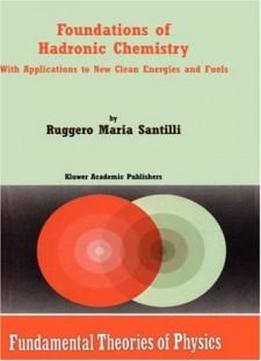
Foundations Of Hadronic Chemistry: With Applications To New Clean Energies And Fuels (fundamental Theories Of Physics)
by Ruggero Maria Santilli /
2001 / English / DjVu
5.1 MB Download
Despite outstanding achievements, Quantum Chemistry has failed to achieve exact representations of molecular data from exact quantum principles. Hadronic Chemistry is a new, nonlinear, nonlocal and nonunitary covering discipline which admits all quantum models as particular cases, while permitting invariant representations of molecular data exact to any desired accuracy. These results are due to a new mathematics necessary for the invariant treatment of nonlinear, nonlocal, and nonunitary theories, known as Santilli isomathematics, and a new structure model of molecules with strongly attractive correlations of valence electron pairs in single couplings, which correlations are nonlinear, nonlocal, and nonunitary, thus outside all the capabilities of Quantum Chemistry. Following a systematic presentation of the basic methods, the new model of molecules, and its experimental verifications, the author applies Hadronic Chemistry to the prediction and experimental verification of a new chemical species, called magnecules, consisting of stable clusters of molecules, dimers, and individual atoms under new non-valence internal bonds. Finally, the author applies all these results to the industrial development of new, clean energies and fuels.
Despite outstanding achievements, Quantum Chemistry has failed to achieve exact representations of molecular data from exact quantum principles. Hadronic Chemistry is a new, nonlinear, nonlocal and nonunitary covering discipline which admits all quantum models as particular cases, while permitting invariant representations of molecular data exact to any desired accuracy. These results are due to a new mathematics necessary for the invariant treatment of nonlinear, nonlocal, and nonunitary theories, known as Santilli isomathematics, and a new structure model of molecules with strongly attractive correlations of valence electron pairs in single couplings, which correlations are nonlinear, nonlocal, and nonunitary, thus outside all the capabilities of Quantum Chemistry. Following a systematic presentation of the basic methods, the new model of molecules, and its experimental verifications, the author applies Hadronic Chemistry to the prediction and experimental verification of a new chemical species, called magnecules, consisting of stable clusters of molecules, dimers, and individual atoms under new non-valence internal bonds. Finally, the author applies all these results to the industrial development of new, clean energies and fuels.











